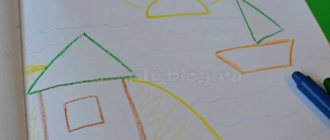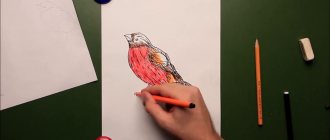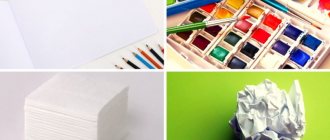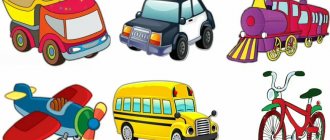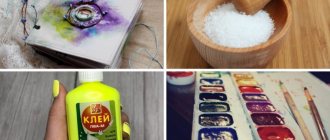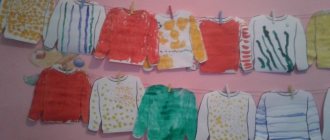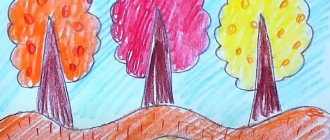Drawing for a child is not only a useful and exciting skill, it is a way to express their personal “I”.
Although some parents do not see the point in children's scribbles, the first drawings indicate the functioning of the brain and teach the baby to think and analyze. The benefits of drawing for children are a scientifically proven fact, repeatedly confirmed by parental experience.
Teaching drawing to a child 2-3 years old
You need to get the most out of the image. The child first draws with vertical, wavy lines. He still has difficulty coloring objects.
First line technique
First you need to introduce your child to drawing subjects. The hand should hold the pencil correctly, the brush should be rinsed in a glass of water. The best way to learn is through demonstration. You can sit down at the table next to your baby, take a pencil and start drawing your drawing, or try to control your child’s hand. You need to take more paper to spread it all over the table.
Important! It should be understood that drawing with children 2-3 years old starts small. To begin with, you need to be content with incomprehensible lines.
The benefits of drawing for child development
Drawing helps you understand the world faster, but this is not the only advantage of such activities, there are others:
- development of fine motor skills of the hands. At 2 years old, the baby learns to hold objects and direct them correctly. Children become smarter and their speech develops faster. Psychologists describe the presence of reflex points on the fingers, from which the signal enters the brain. From their stimulation mental abilities develop;
- the emergence of purposefulness;
- figurative thinking. In the future, for memorization, it is important to associate objects with images;
- emphasizing attention and imagination;
- development of mathematical abilities and logic. Shapes of objects, comparison, equality - these are simple concepts in mathematics that are ingrained in childhood.
The role of drawing in the development of a child
Drawing is directly related to imagination, speech, mental activity and perception of the surrounding reality. Fine art enhances and organizes these mental functions, helping the little artist to systematize his idea of the surrounding reality.
The more actively a child understands the world through games, the better he draws, developing his creative abilities, and therefore developing his intellect. Giving your baby a pencil and paper is not only a way to keep him busy for a while.
The benefits of drawing for children are undeniable and scientifically proven, since artistic activities:
- give joy. Drawing becomes a hobby for the child, which brings great pleasure, as it gives freedom of expression;
- develop perseverance and accuracy. Holding a pencil in hand is not an easy task for a child, and depicting a specific object is a painstaking and difficult task. While performing it, the baby goes through an important process - the development of fine motor skills: the better he masters this stage, the faster speech will develop;
- train memory, attention, improve spatial imagination;
- help to cope with emotions, making the baby happier and freer, because through drawing the baby “splashes out” on paper his feelings, which due to age he cannot express through speech;
- develop creative potential. Creating a drawing or painting requires a child to have an individual vision of objects, requires a creative approach to the creative process, the ability to admit one’s mistakes and, as a result, create something unique;
- calm the psyche: it is especially useful to draw for children prone to whims and neuroses;
- help reveal individuality. When drawing, a child feels like a creator, an individual, which makes him more confident and has a beneficial effect on self-esteem.
From a child's drawing you can understand who its author is - a boy or a girl. This is a scientific fact. Girls have better developed verbal and logical thinking, emotions, and attention to detail. They are focused on a specific image, they like to draw princesses and animals. Boys are distinguished by spatial imagination, so they usually depict dynamic pictures - battles with equipment and weapons.
Only a child psychologist can interpret the drawing and only taking into account the child’s own comments. If a child prefers to depict objects in black, this does not mean that he is depressed, but simply an association with his father’s car.
How to interest a child
In any business, the most important thing is interest. You can get used to drawing if your child loves it. There are several ways:
- Emotional perception of an adult. The parent should praise and rejoice. Through the emotions of an adult, you can achieve success in drawing a child.
- Turn the lesson into a game. You can come up with a game plot that will be interesting to the baby. For example, a bunny asks for a carrot, you need to draw it. The game should be filled with meaning. You can conduct a dialogue, show the child a toy hare.
- Process. We must not forget about the most important thing. The first drawing will definitely impress the little one, so there should be a lot of different paints, pencils, and felt-tip pens on the table. Many new objects are the main attribute of the first “picture”. The second and third pictures will be even better.
How to make a privacy corner in a kindergarten with your own hands
Image techniques
To understand how to teach a child to draw at 3 years old, you need to consider drawing techniques. From a variety of options, you can choose the most effective ones for your baby.
Poking technique
- Poking drawing. The adult selects the plot of the template that needs to be supplemented. It is recommended to choose a semi-dry, hard bristle brush with gouache paint. A felt-tip pen will also work. You can color a snowman, animals, plants. This technique will help you learn how to color.
- Dipping. For this method it is better to choose paints. The child holds the brush diagonally closer to the table (in the vertical poke technique) and leaves brush marks. These could be tracks of an animal, lights on a Christmas tree, patterns on clothes. You can print a black and white picture or draw it yourself.
- Fingerprints. Apply a little paint to a white sheet and show how to paint with your fingers. You should be careful when choosing paints, because babies’ skin is very delicate and susceptible to allergies and irritations. You should choose gouache and watercolor.
- Drawing with lines. This is a more complex stage that needs to be introduced after studying the first three techniques described above.
Examples of custom drawing
The methods can be adapted for younger and older children.
Drawing on sand/semolina with a finger/stick.
All kids like this method. It develops fine motor skills and tactile sensitivity. If possible, build something like a light cube - a box with a transparent lid with a light bulb inside. Drawing on a thin layer of sand on such a box is very entertaining.
Coloring crafts made from salt dough.
After modeling, you may end up with various figures that your child will be happy to paint. If he still doesn’t understand well that mixing all the colors in a row will only result in “dirt,” give him one jar of paint at a time. Then, when the drawing on the figure dries, take out the next color.
Drawing with crayons on stones.
If you go to the sea or to a rocky beach in the summer, be sure to take a box of crayons with you. While you are sunbathing, your baby will have something to do - coloring rock candy.
Drawing with colored ice.
This activity is especially relevant for hot summer days. Freeze ice cubes by adding colorful paints to the water (regular watercolor will do). Place your child on a piece of Whatman paper and give him a container of colored ice. Having coped with the task of removing the cold cubes, he will move them around the paper until they melt.
Use of available materials.
Draw with everything you can get your hands on! (Well, or almost everyone...) Study the result, comment, discuss with your child. You can dip glass balls in paint and roll them inside the box: let the child tilt the box to the sides and follow the multi-colored trace. You can use a fork to draw a lion's mane, spruce paws, or hedgehog needles. And so on!
If your son is passionate about cars, dip the wheels in paint and let him “drive” his vehicle on a piece of whatman paper. And you help him draw a road, trees along the road, a traffic light and a pedestrian crossing.
Drawing as part of the game.
Combine drawing with other activities: appliqué, paper crafts, and natural materials. Maybe you have fabric paints at home? Buy a white T-shirt and let your child design it himself! You can print his palms on a T-shirt - not only will it be a drawing activity, but it will also be a memory for many years.
Workspace organization
The workplace should both attract and teach organization.
- First you need to take care of the child's health. The table and chair included must be adjusted to the height of the child. The back is rigid for correct posture. During work, you need to monitor his body position, carefully guide him without knocking him out of his work.
- Interesting design. It’s always nice when your child’s desk matches the interior of the room, but you shouldn’t forget about visual perception. The workplace should attract the little one.
- Before drawing with children 2-3 years old, you need to prepare a table. It is advisable to do this in front of a child. Carefully laid out paints and pencils will teach him order. After classes you need to clean everything up. Again, you can come up with a game that will teach your child to keep order, then in the future during school lessons he will keep his workplace clean.
At what age should I start?
There is no need to rush the event. Experts recommend introducing a baby to drawing from the age of eight months: by this time the child can sit confidently. It is advisable to start with finger paints and a large sheet of paper. You need to be prepared for the baby to get everything dirty.
Some psychologists believe that teaching children to depict real objects: clouds, trees, houses, geometric shapes is not recommended until the age of 8, so as not to discourage the little artist from wanting to draw.
It should be understood that preschool children convey their visual and tactile sensations from the object in the drawing. They are not interested in the similarity of the object. The period of doodle drawing has its own stages and at this time it is important to prevent the baby from blocking this process:
- chaotic scribbles (up to a year) . This is the time when a child just picks up a pencil, pokes it at a piece of paper, rejoicing that traces remain there. Parents should provide feedback to the baby, reacting positively to his creativity;
- circular scribbles (1-2 years) . Now the baby realizes that he can control his movement and actively draws circles, lines, and squiggles. At this stage, parents are tempted to teach their child to draw correctly: a square house, a round sun. Such actions block the child’s imaginative thinking;
- advanced doodles (2-3 years) . This is the last period of “pre-fine” drawing, in which the baby discovers that there is meaning in the circles, dots and curved lines he draws. The process should bring joy to the child: in order to maintain the child’s self-esteem, parents should even hang doodles on the wall, admire them and proudly show them to friends.
Realistic appearance of objects appears in children's drawings only by the age of 7-8 years. It is during this period that the child has a desire to evaluate an adult in order to achieve a better result and the question arises about the need to continue studying at an art school.
How to teach a 3 year old child to draw
The first image should interest the child so that next time he starts drawing again. To teach a 3-year-old child to draw, you can use one of the techniques.
Hatching on coloring books
- The coloring technique will help your child choose the right colors. You need to help him not go beyond the line by coloring two or three objects yourself. You need to start with simple coloring books: a house, a car made of shapes, a flower.
- Technique of improvised means. You can try drawing with toy vehicles or threads. You can lay out patterns with them and then paint them.
- Drawings that develop mathematical skills: lines, ovals, circles. These can be provided as templates. For example, a drawing of a boy with colorful balls.
Classes on cognitive development in preparatory groups
Simple drawing lessons for kids
I usually teach these simple drawing lessons with kids. Children's drawings using the finger painting technique are very interesting. Here's how to do it:
- Invite your child to dip his finger in the paint. Now place your finger on a piece of paper, you will get a speck.
- Help me draw a petal or some kind of caterpillar.
- Drawing lines, draw rays like the sun.
Let the child now try to draw something himself. As his hands become more confident at age 5, you can teach him to use a brush. You need to show your child the three basic skills of painting with a brush; show how to wash it before adding new paint.
There are several ways to paint with a brush:
- By dipping. We draw, lightly touching the paper, and immediately remove the brush, applying spots of paint. Let a 3-year-old child observe how the image is produced.
- Strokes technique. From the age of 3, carefully draw lines in a variety of directions. Let them differ in length.
- Draw a sketch using a pencil with 8. First, make basic lines and a sketch using a pencil, and then color it.
As your skills develop, the tasks will become more difficult. There are very interesting techniques. They can be mastered by conducting regular activities with the child. To consolidate a particular skill, several lessons are required.
How to draw a rainbow and a butterfly (2 videos)
Ideas for children's drawings (19 photos)
Interesting drawing ideas
Interesting image options can give the child more knowledge. Choosing the right coloring book is the responsibility of the parent.
You can make your own coloring in the form of the seasons, combining all the image techniques.
- autumn: dipping technique for colorful leaves;
- winter: poke technique for the New Year tree. A winter landscape provides many ideas (a snowman for understanding shapes, sports equipment for introducing activities);
- spring: dipping technique for drawing buds and first leaves;
- summer: understanding shapes (ice cream), drawing with a poke (flowers).
What topic to choose
Parents often have questions about how best to draw: painting objects step by step or first seeing the finished result. It is difficult for a child to select exact colors for objects, so it is better to initially demonstrate how, for example, a flower should look, and then complete the drawing step by step.
Note! The topic must relate to real objects. No need to start with coloring pages of non-existent cartoon characters. You can even show off the item for the image first.
Drawing with fingers and palms
Children may be interested in hand painting. Using this technique you can depict flowers and the sun. The method is very easy, since no additional items are needed for the lesson.
For your information! There are special finger coloring books on sale.
Picture of palms
Should I send my child to a drawing class?
The optimal age for a child to study in a circle is 4-6 years. Your baby's social communication skills should develop gradually.
Important! A sudden introduction to a group of guys can be stressful for him. There is no need to rush into learning; the basic basics can be learned at home.
Recommendations from psychologists and teachers
Psychologists note the importance of feedback between adults and children. Drawing not only gives certain skills, but also brings parents and baby closer together. Teachers advise starting with coloring books so that the child remembers the object itself. It is still difficult for him to depict a flower that he saw on the street once. Simple lines can also be the goal of drawing for children 2-3 years old.
The first “picture” for the baby is a step towards a complex activity. It is useful to develop drawing skills to improve mental abilities. When choosing basic techniques, you need to choose the most suitable and interesting one for the child. Don’t forget about personal contact with the baby, then drawing will not just be a lesson, but will develop into a hobby.
